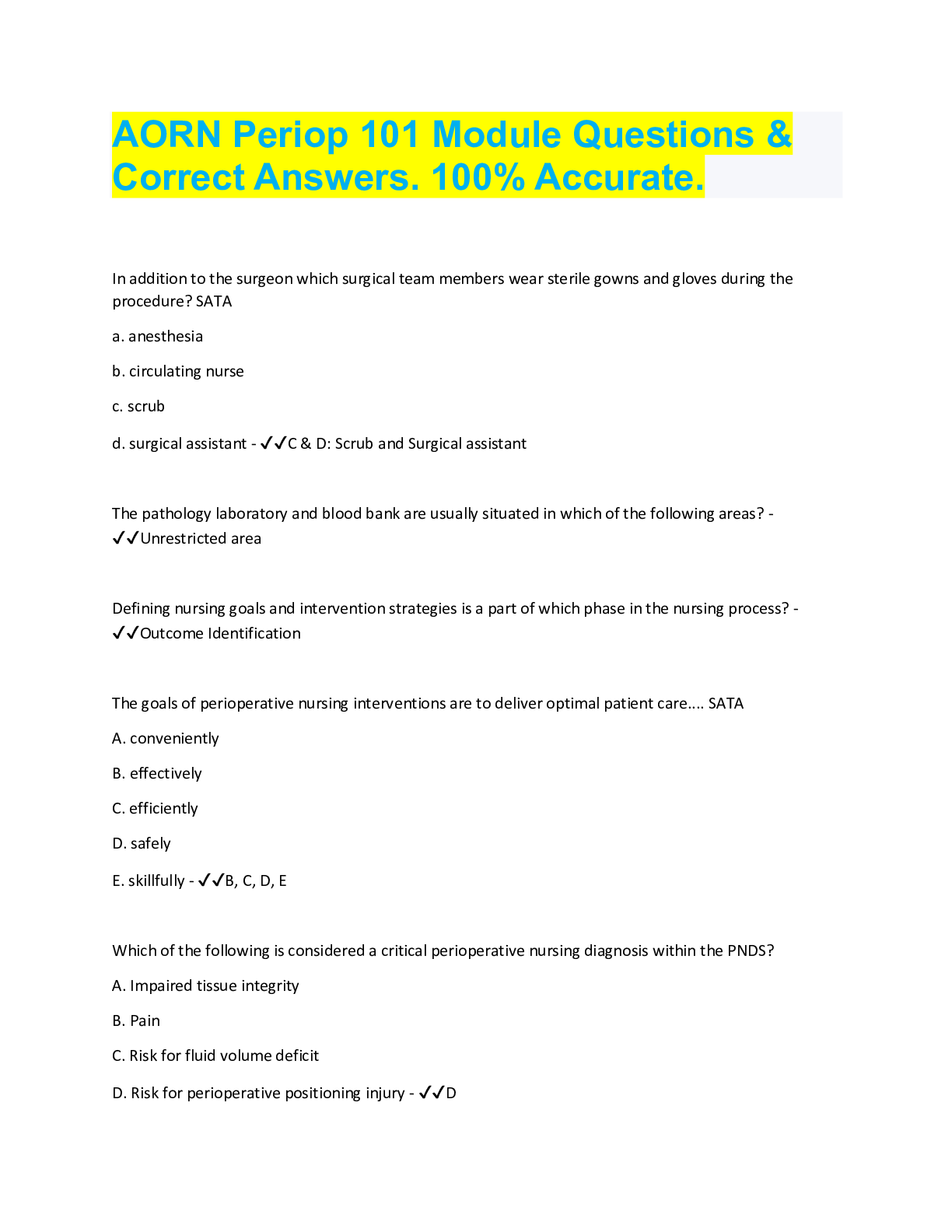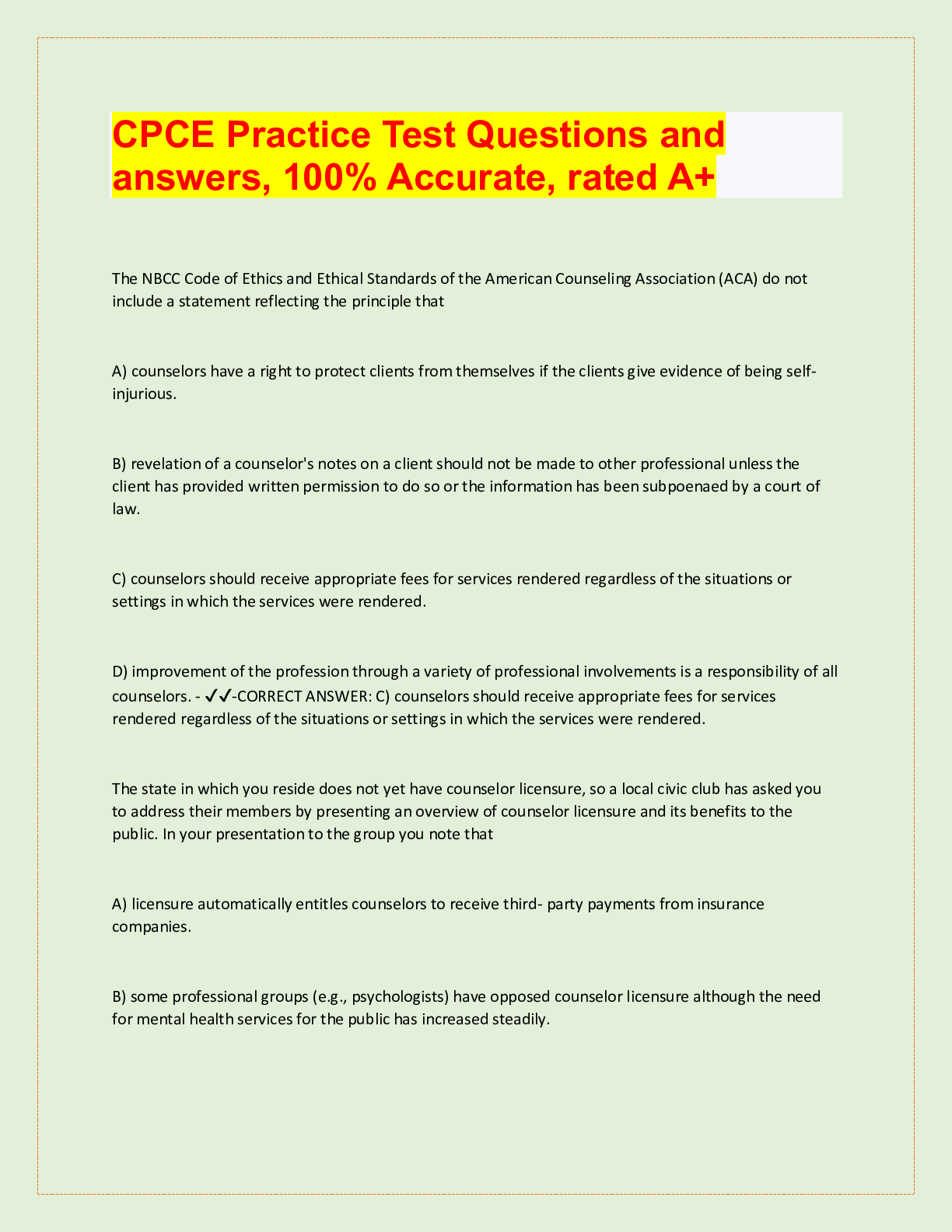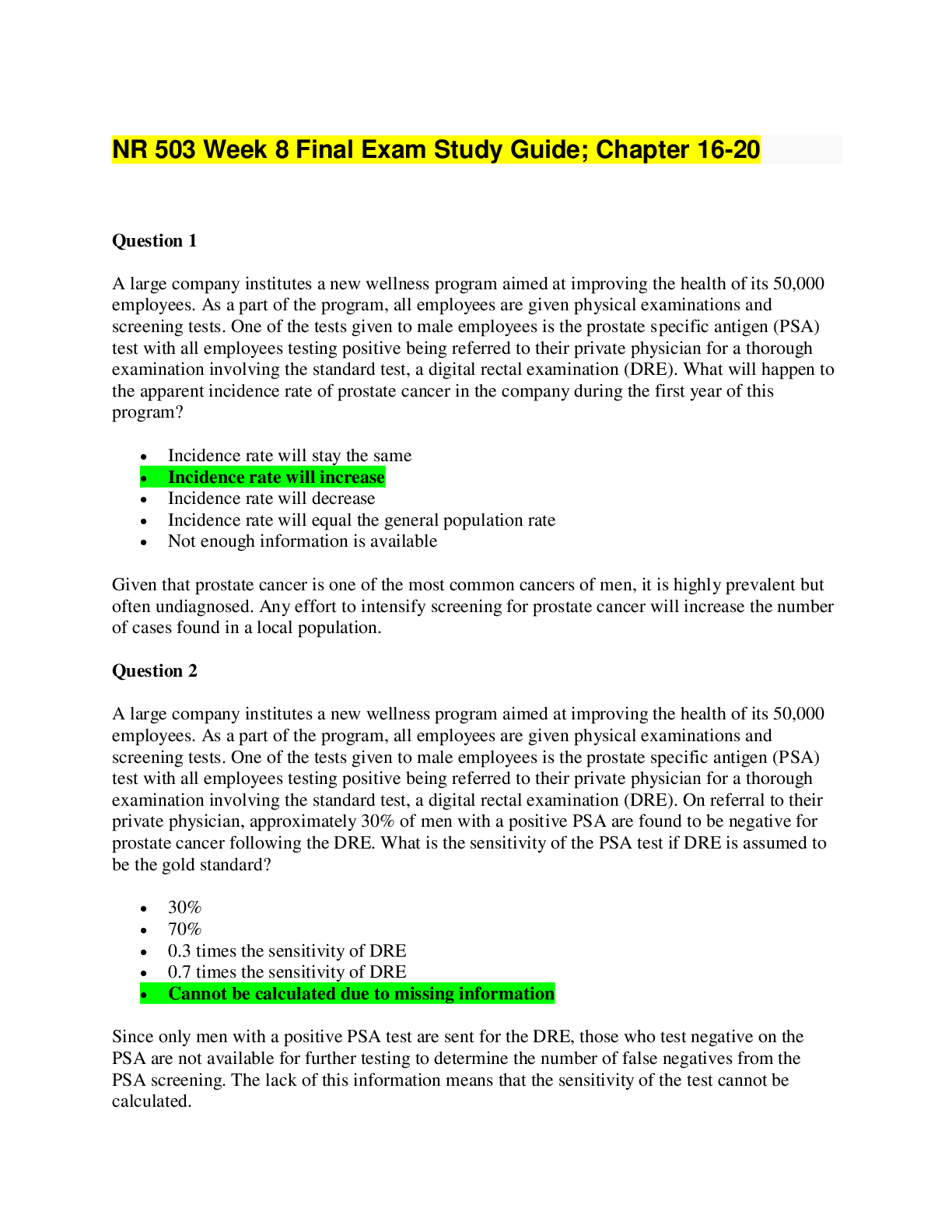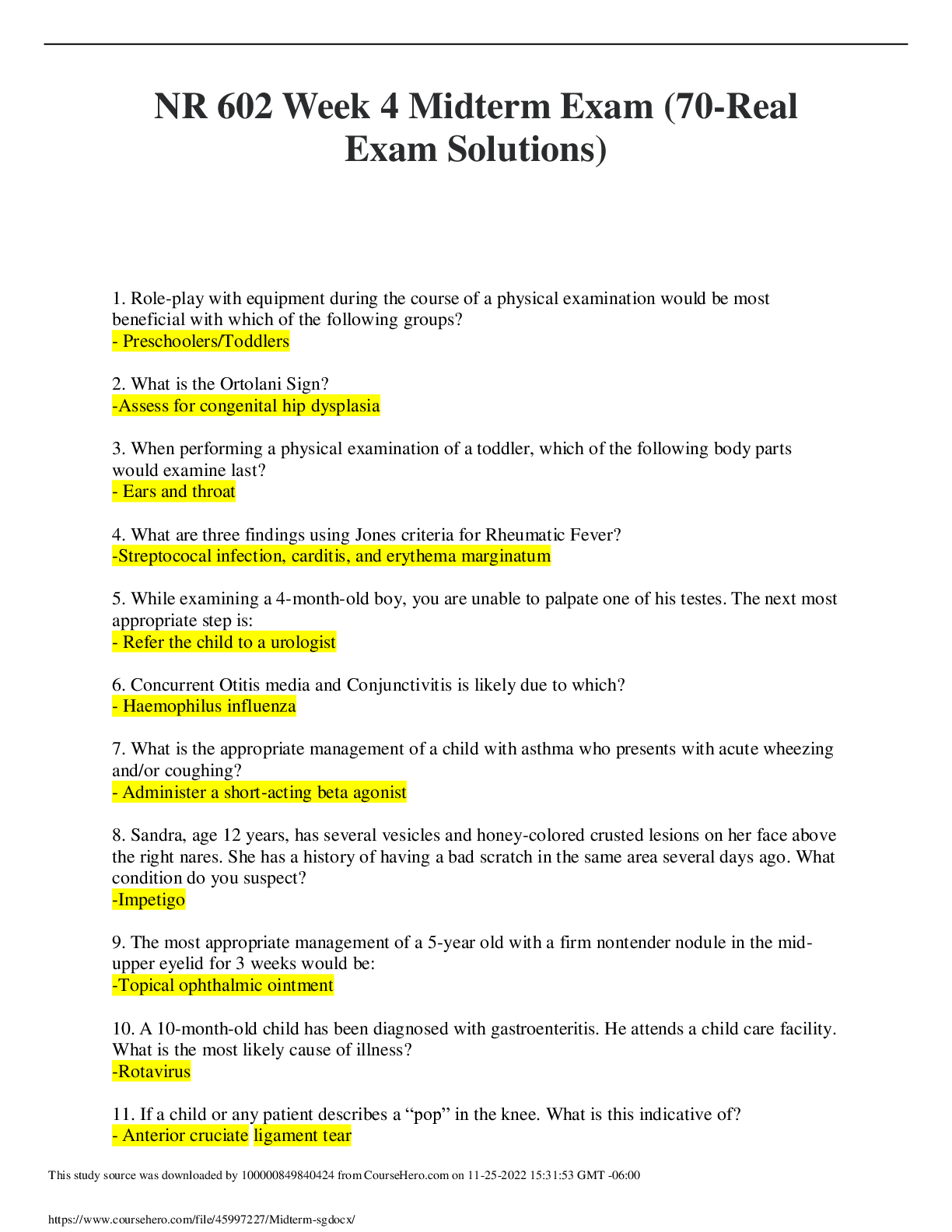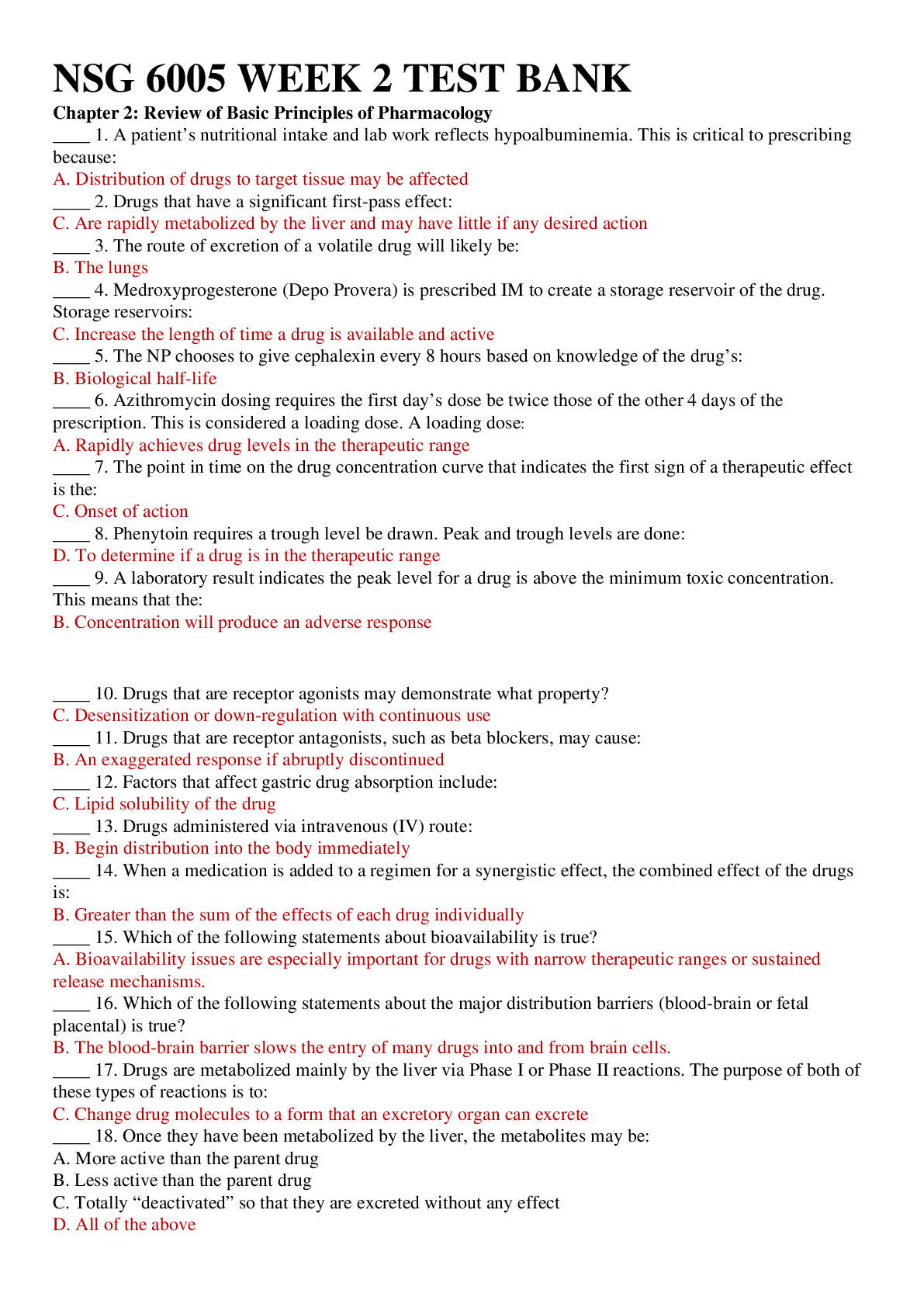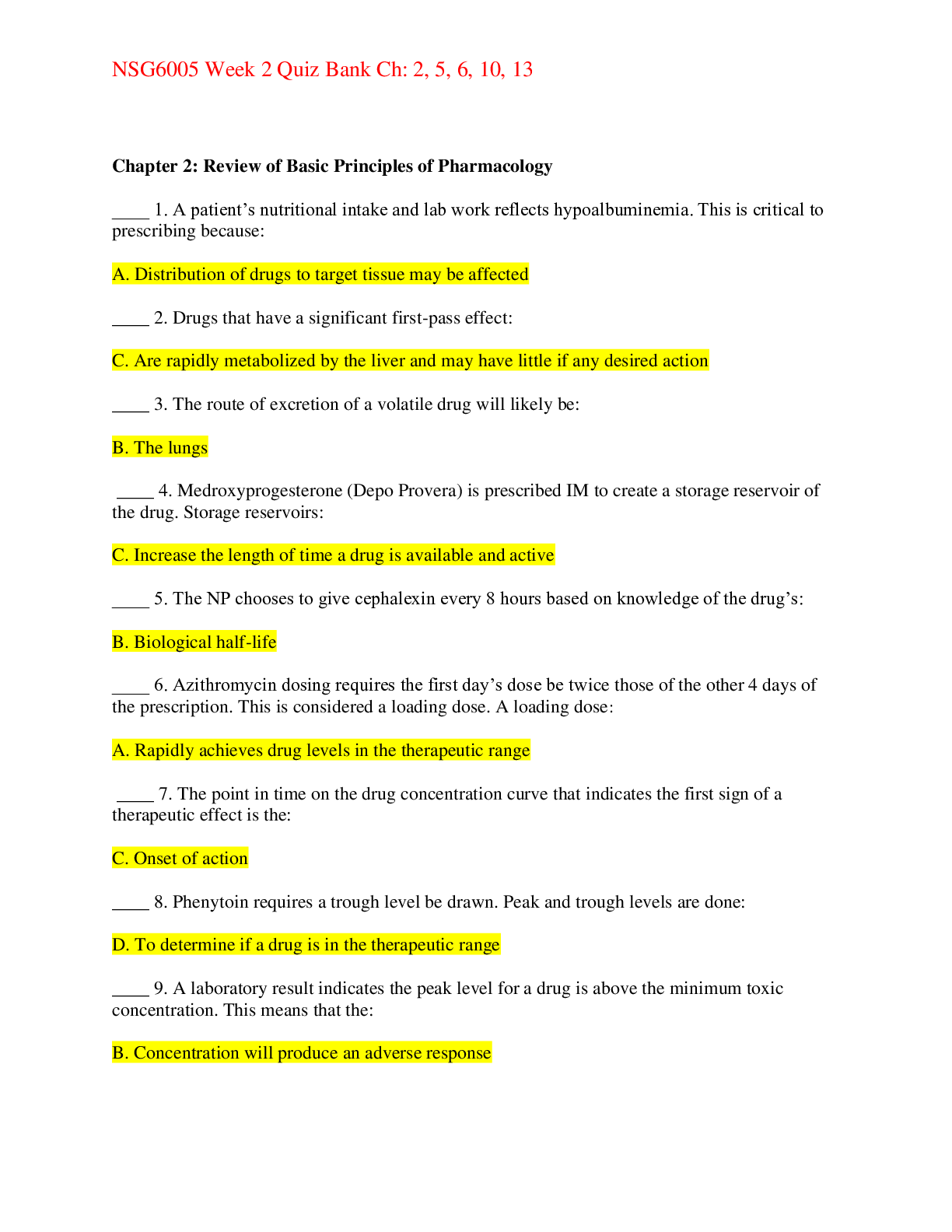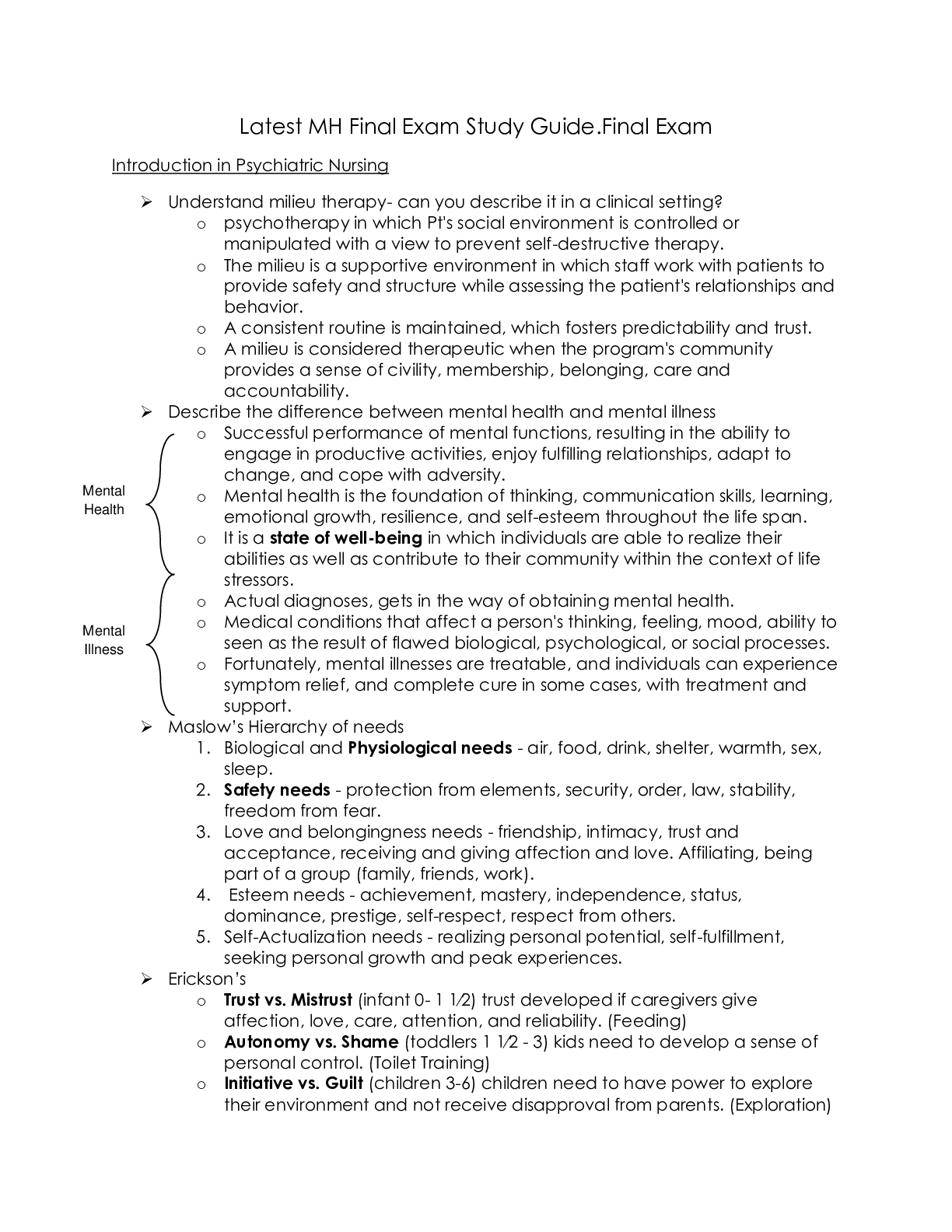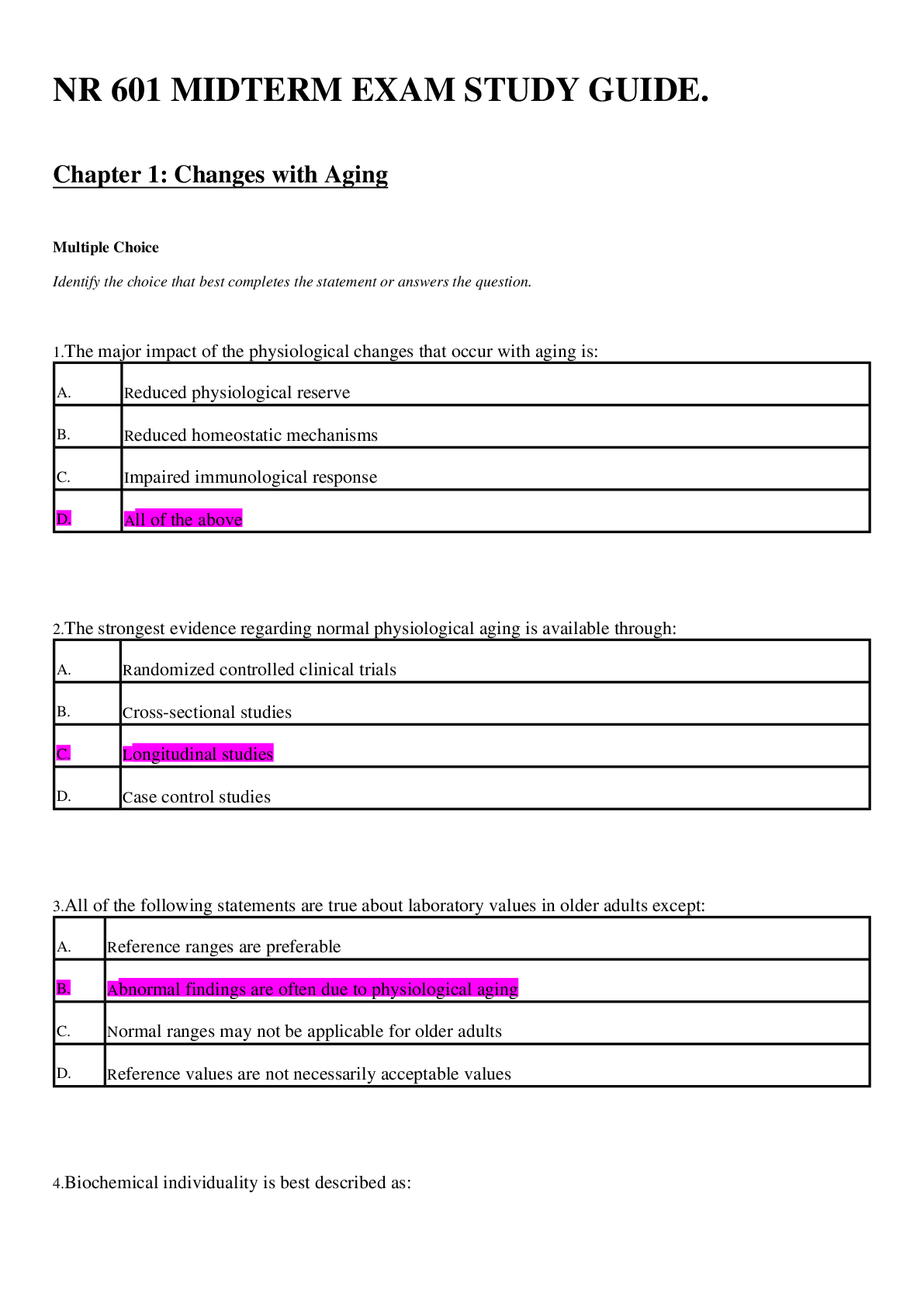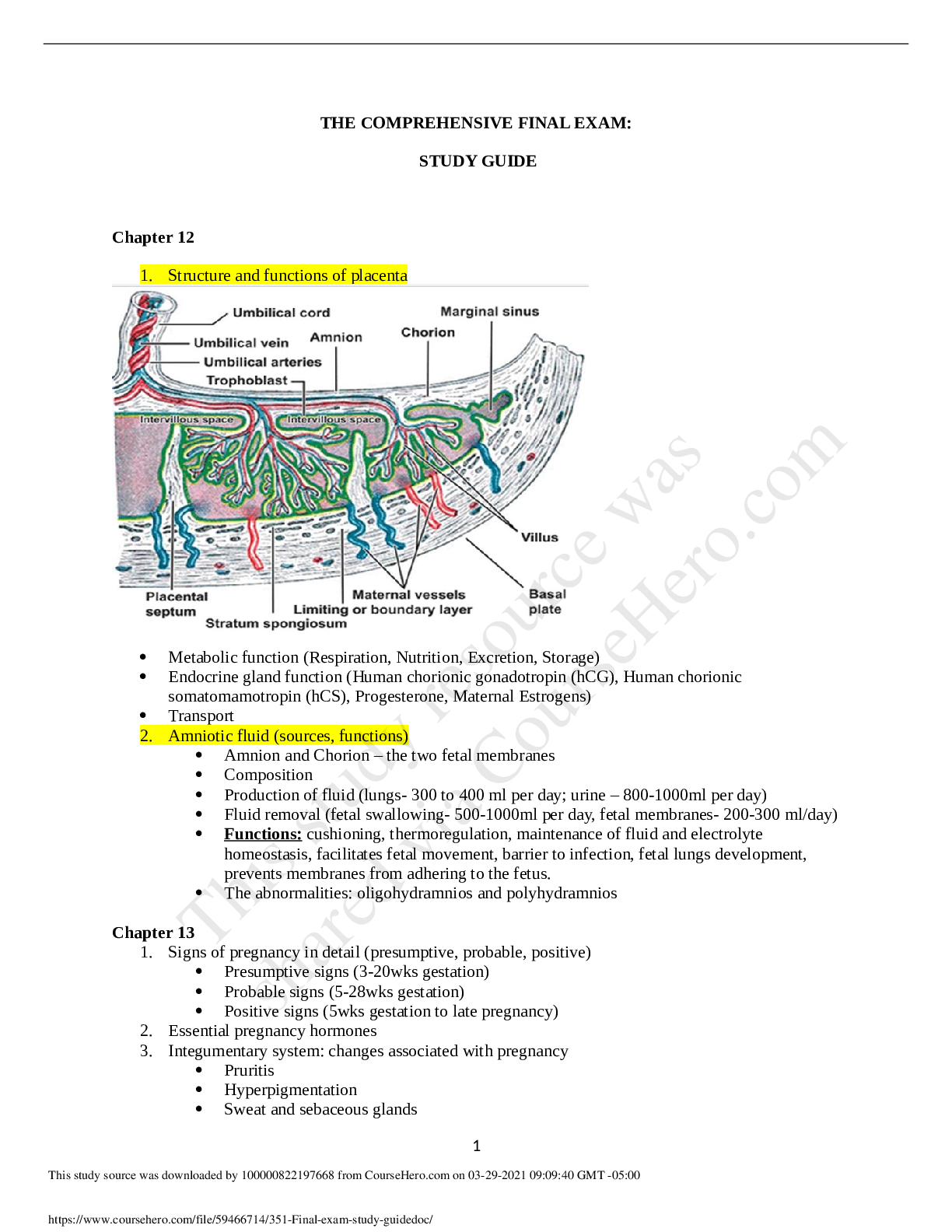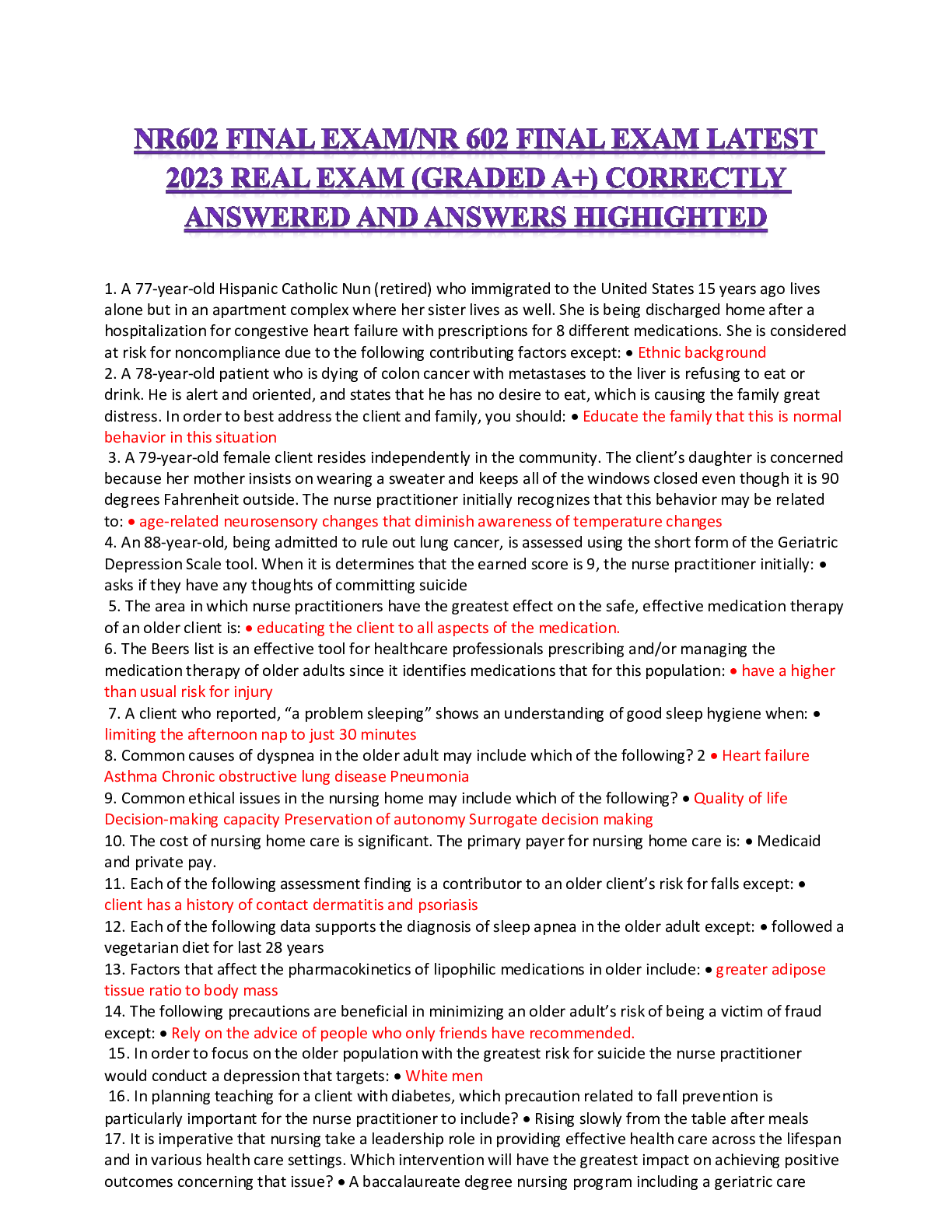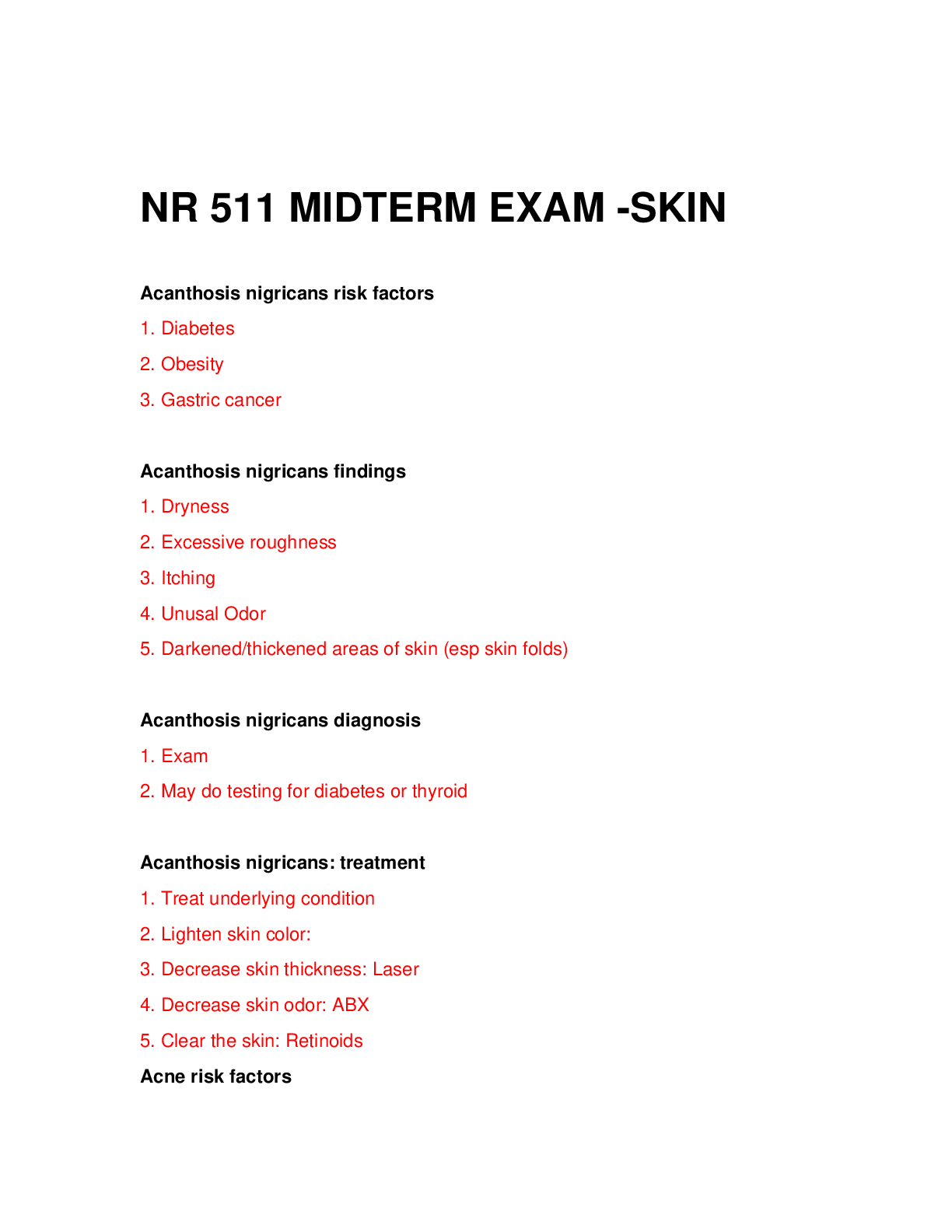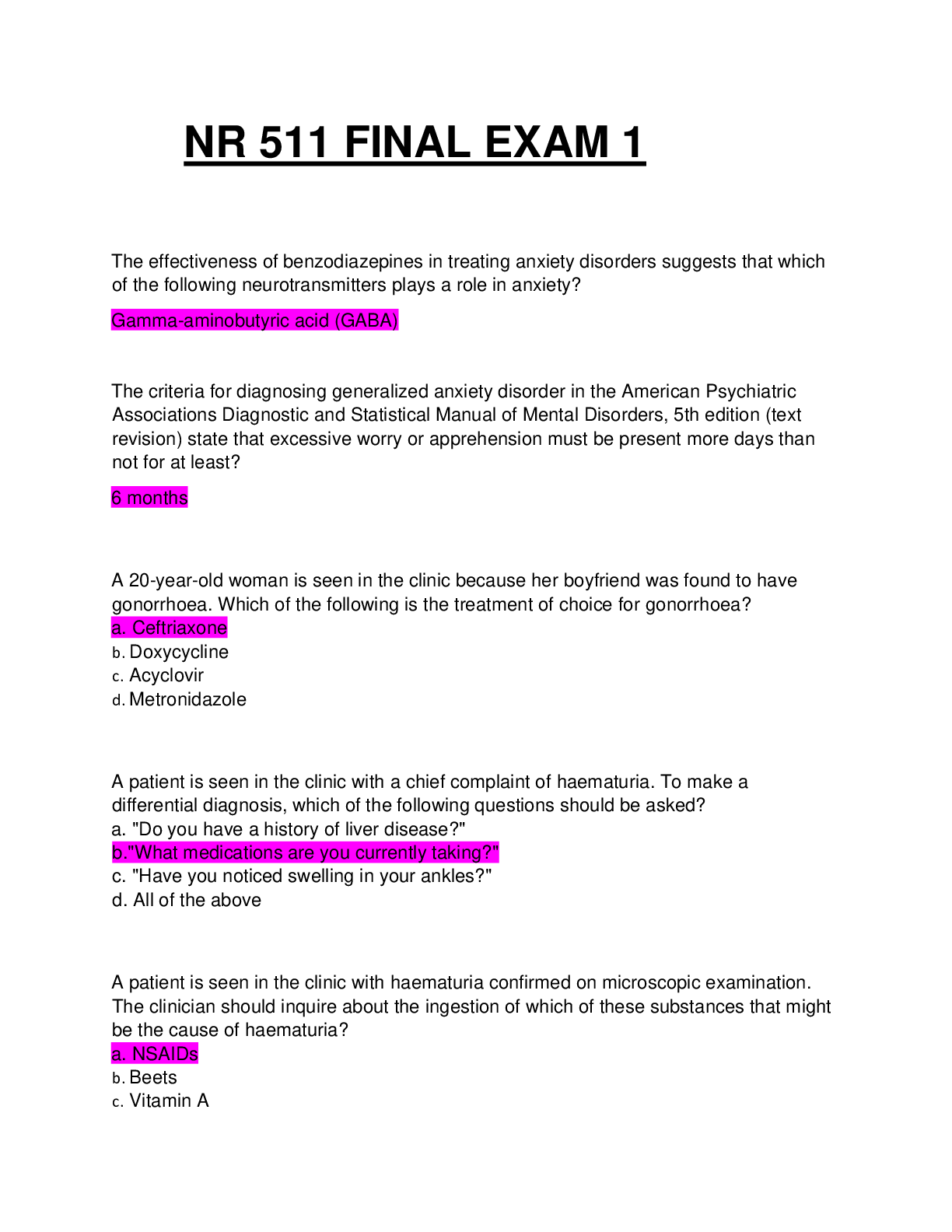Social Sciences > QUESTIONS & ANSWERS > DSM 5 Exam Study Guide. Complete coverage of examinable sections. Quizzes. Rated A (All)
DSM 5 Exam Study Guide. Complete coverage of examinable sections. Quizzes. Rated A
Document Content and Description Below
DSM 5 Exam Study Guide. Complete coverage of examinable sections. Quizzes. Rated A Schizophrenia Spectrum and Other Psychotic Disorders - ✔✔-Includes schizophrenia, other psychotic disorder... s, and schizotypal (personality) disorder -schizotypal personality disorder -delusional disorder -brief psychotic disorder -schizophreniform disorder -schizophrenia -schizoaffective disorder -substance/medication-induced psychotic disorder -psychotic disorder due to another medical condition -catatonia associated w/ another mental disorder (Catatonia specifier) -other specified..., and unspecified... -[attenuated psychosis syndrome] Defined by abnormalities in one or more of the following five domains: 1. delusions 2. hallucinations 3. disorganized thinking (speech) 4. grossly disorganized or abnormal motor behavior (including catatonia) 5. negative symptoms Delusions - ✔✔-Fixed beliefs that are not amenable to change in light of conflicting evidence. -bizarre -persecutory -grandiose -erotomanic -nihilistic -somatic -thought withdrawal -thought insertion -delusions of control One of the five domains of schizophrenia spectrum and other psychotic disorders. Hallucinations - ✔✔-Perception-like experiences that occur without an external stimulus. They are vivid and clear, with the full force and impact of normal perceptions, and not under voluntary control. May occur in any sensory modality but auditory are the most common in schizophrenia and related disorders. One of the five domains of schizophrenia spectrum and other psychotic disorders. Disorganized Thinking (speech) - ✔✔-Typically inferred from the individual's speech (also known as formal thought disorder). The individual may switch from one topic to another (derailment or loose associations). Answers to questions may be obliquely related or completely unrelated (tangentiality). Rarely, speech may be so severely disorganized that it is nearly incomprehensible and resembles receptive aphasia in its linguistic disorganization (incoherence or "word salad") Because it is common and nonspecific, the symptom must be severe enough to substantially impair effective communication. Less severe symptoms may occur during the prodromal and residual periods of schizophrenia. One of the five domains of schizophrenia spectrum and other psychotic disorders. Grossly Disorganized or Abnormal Behavior (including catanoia) - ✔✔-May manifest itself in a variety of ways, ranging from childlike "silliness" to unpredictable agitation. Problems may be noted in any form of goal-directed behavior, leading to difficulties in performing activities of daily living. One of the five domains of schizophrenia spectrum and other psychotic disorders. Catatonic Behavior - ✔✔-A marked decrease in reactivity to the environment. -ranges from resistance to instructions (negativism) to maintaining rigid, inappropriate or bizarre posture to a complete lack of verbal and motor responses (mutism and stupor) -can also include purposeless and excessive motor activity without obvious cause (catatonic excitement) -repeated stereotyped movements, starting, grimacing, mutism and the echoing of speech -catatonic symptoms are nonspecific and may occur in other mental disorders (bipolar or depressive disorders with catatonia) and in medical conditions (catatonic disorder due to another medical condition) Included in the Grossly Disorganized or Abnormal Motor Behavior domain of schizophrenia spectrum and other psychotic disorders. Negative Symptoms - ✔✔-Account for a substantial portion of the morbidity associated with schizophrenia, but are less prominent in other psychotic disorders. Two are most prominent in schizophrenia: -diminished emotional expression -avolition Others include -alogia -anhedonia -asociality One of the five domains of schizophrenia spectrum and other psychotic disorders. Diminished Emotional Expression - ✔✔-Includes reductions in the expression of emotions in the face, eye contact, intonation of speech (prosody), and movements off the hand, head and face that normally give an emotional emphasis to speech. A type of negative symptom. One of the two most prominent negative symptoms in schizophrenia. Avolition - ✔✔-A decrease in motivated self-initiated purposeful activities. The individual may sit for long periods of time, and show little interest in participating in work or social activities. A type of negative symptom. One of the two most prominent negative symptoms in schizophrenia. Alogia - ✔✔-A negative symptom that is manifested by diminished speech output. Anhedonia - ✔✔-A negative symptom in which there is a decreased ability to experience pleasure from positive stimuli, or a degradation in the recollection of pleasure previously experienced. Asociality - ✔✔-A negative symptom that refers to the apparent lack of interest in social interactions and may be associated with avolition, but it can also be a manifestation of limited opportunities for social interactions. Genetics Factors of Schizophrenia Spectrum and Other Psychotic Disorders - ✔✔-Increased risk of Schizophrenia in first degree relatives: -risk of one parent w/ schizophrenia: ~13% -risk of two parents w/ schizophrenia: ~50% Twin studies: -large differences in concordance rates between monozygotic (MZ) and dizygotic twins (DZ) -MZ: 25-50% -DZ: 6-15% -shared environment may contribute up to 11% of variance in symptom onset Not just genetic. -80% of persons w/ psychotic symptoms do not have a parent with disorder -60% have a negative family history Prevalence of Schizophrenia Spectrum and Other Psychotic Disorders - ✔✔-Delusional Disorder: ~0.2% (lifetime) M=F Brief Psychotic Disorder: In US, may account for 9% of first onset psychotic disorder -2:1 F:M Schizophrenia: 0.3-0.7 (lifetime) -onset males: early to mid 20s -onset females: late 20s Schizoaffective Disorder: 0.3% (lifetime) -F>M due to increase incidence of depressive subtype in women -typical age of onset = early adulthood -over diagnosis of schizophrenia vs. schizoaffective disorder in African Americans and Hispanic population (be careful to assess both affective and psychotic symptoms) Risk Factors of Schizophrenia Spectrum and Other Psychotic Disorders - ✔✔--migrant status -older fathers -toxoplasmosis gondii antibodies -prenatal famine -lifetime cannabis use -winter or spring birth Perinatal Factors: -increased risk in infants of mothers exposed to influenza during second trimester and birth during winter months Obstetric Complications: -preeclampsia -breech -other abnormal presentation -labor > 36 hours or labor < 3 hours -cord prolapse -forceps delivery -(all or > 2) Age and Sex: -onset in males is 3-5 years earlier than females -onset before 10 yrs old is very rare -onset after 50 yrs old is very rare -prevalence is equal between boys and girls until puberty -prevalence is greater in men than women throughout most of adulthood -prevalence in higher in women after age 45 -no difference in prevalence by the end of life -women tend to have a less severe course of the illness and are more responsive to antipsychotic drugs Social Class: -Lower SES and elevated rate -cause vs. effect (stress vs. social drift) Urban: -incidence higher among children growing up in urban environment Culture: -prevalence of schizophrenia is similar across cultures -course of illness may be more benign in developing countries compared to industrialized nations Family: -expressed emotion-instrusive, critical, hostile -etiology vs. effect of ill person on family Stressful life events: -high rates of psychotic disorders among new immigrants -rates approximate native born over time -higher rate of stressful events immediately prior to hospitalization Cannabis use: -increased risk of psychotic disorder in cannabis users (OR is ~1.41) -dose related effect - greater risk among those who use most frequently (OR is ~2.09) Biological Basis of Schizophrenia - ✔✔--dopamine hypothesis -brain abnormalities -deficits in cognitive processing Course of the Illness and Prognosis of Schizophrenia Spectrum and Other Psychotic Disorders - ✔✔- Longterm Outcome -67% have at least 1 relapse over 15 years -better services produce better outcomes -review of 10 long-term (>20yrs) follow up studies: 21-57% showed periodic episodes of recovery (improved symptoms, greater social, educational and occupational functioning) -poor ability to predict outcome Outcomes: -full recovery -sporadic psychotic episodes with no inter-episode impairment -sporadic psychotics episodes with persistent but mild cognitive and negative symptoms -sporadic psychotic episodes with severe functional disability between episodes -frequent psychotic episodes with severe functional disability between episodes -no psychotic symptoms after first episode but severe functional disability -continuous psychotic symptoms with severe functional disability -continuous psychotic symptoms with complete functional disability -in general, outcome determined more by circumstances under which illness develops and by premorbid personality than by positive symptoms of illness Males have more hospitalizations and longer stays than women Prodromal phase less than or equal to 5 years -subclinical or attenuated symptoms -ex: disruptions in sleep, anxiety, depression, aggression/irritability, paranoia, and odd beliefs Initial emergence of symptoms (first episode) is a critical time for treatment -widely believed that the earlier antipsychotic medications are initiated, the better the outcome -Deterioration most pronounced during first 5 years of illness -Evidence that each relapse leads to more persistent symptoms and greater cognitive and psychosocial impairment -effective and early intervention does help achieve clinical remission and good outcome Core Symptoms of Schizophrenia Spectrum and Other Psychotic Disorders - ✔✔-Positive symptoms: distorted function (qualitative change) -hallucinations -delusions -disorganized speech -bizarre behavior -inappropriate affect Negative symptoms: diminished function (quantitative change) -perception -inferential thought -thought/language -behavior monitoring -affect Negative Symptoms and Function Diminished -Alogia (absence of words); diminished fluency of speech/thought -Affect Blunted; diminished emotional expression -Avolition; diminished volition and drive -Anhedonia; diminished hedonic capacity -Abulia (gross lack of motivation); diminished motivation Cognitive Impairment -difficulties in verbal and visual learning and memory -working memory -attention/vigilance -abstract reasoning -executive functioning (understanding a concept, planning, organizing) -problem solving -speed of information processing Cognitive deficits observed in: unmedicated, medicated, first episode, remitted, and high risk children prior to developing disorder -viewed as a core feature of schizophrenia -deficits are stable over time and do not reflect progressive deterioration Other Symptoms and Characteristics of Schizophrenia Spectrum and Other Psychotic Disorders - ✔✔- Mood Symptoms: -depression -anxiety -anger Depression is quite commo [Show More]
Last updated: 1 year ago
Preview 1 out of 67 pages
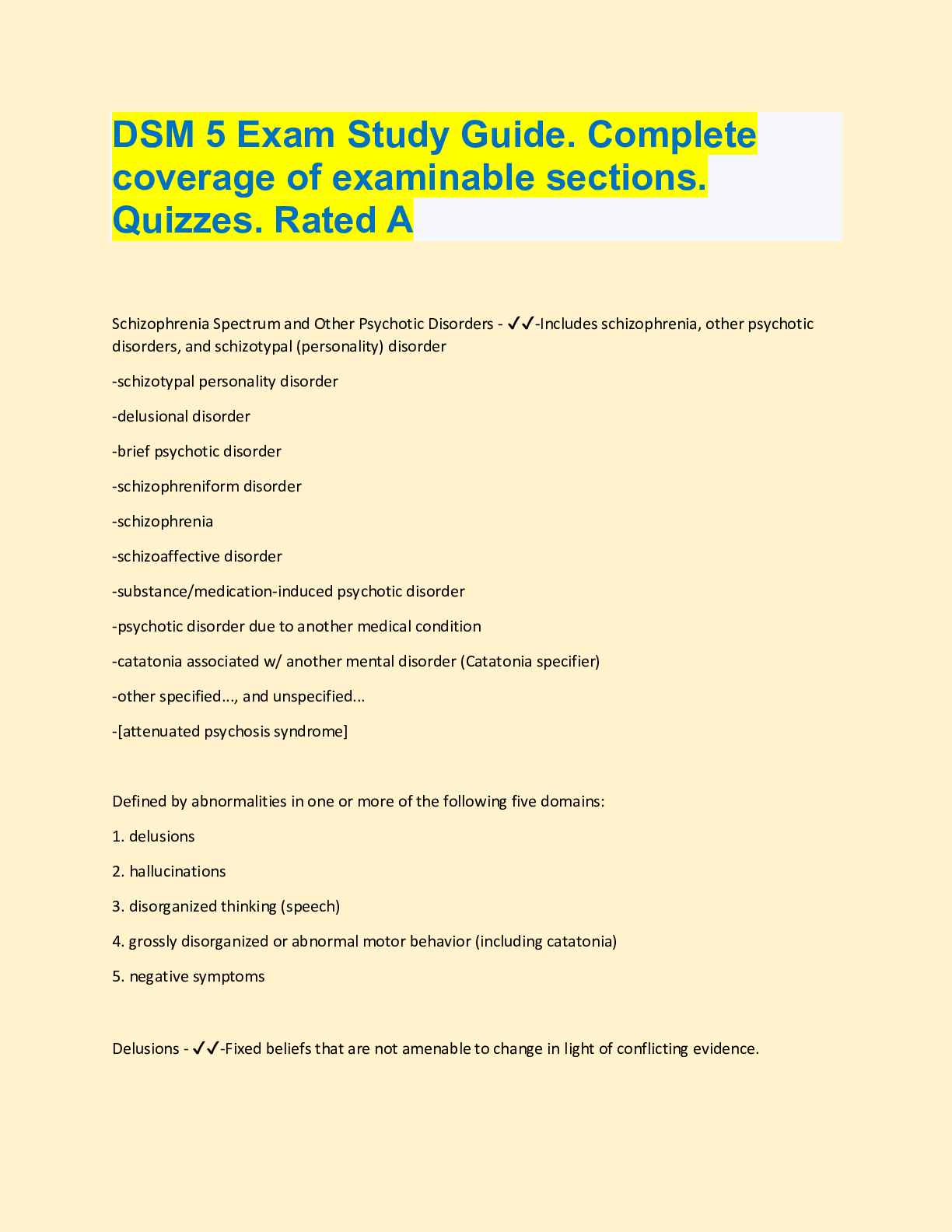
Buy this document to get the full access instantly
Instant Download Access after purchase
Add to cartInstant download
We Accept:

Also available in bundle (1)

DSM 5 Review Bundle, top Questions Exam. verified.
DSM 5 Review Questions and answers, 100% Accurate, rated A+. verified exam predictions.
By Topmark 1 year ago
$38
18
Reviews( 0 )
$13.00
Document information
Connected school, study & course
About the document
Uploaded On
Mar 14, 2023
Number of pages
67
Written in
Additional information
This document has been written for:
Uploaded
Mar 14, 2023
Downloads
0
Views
61






